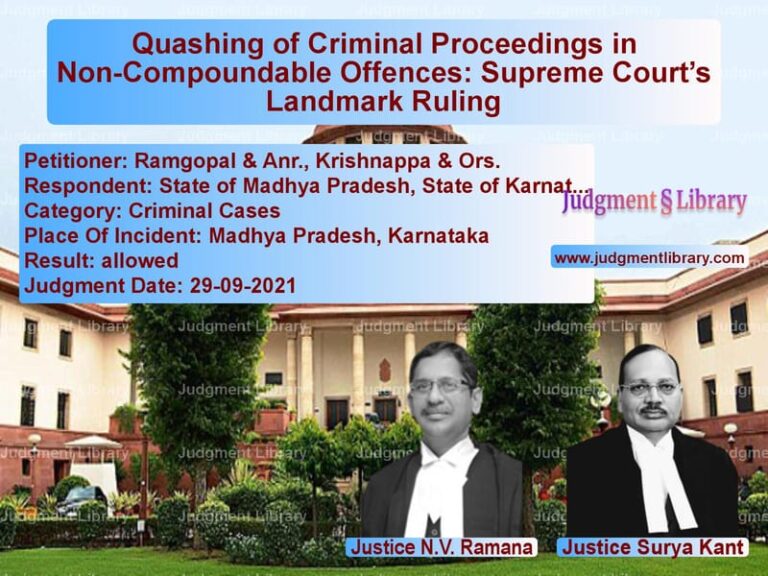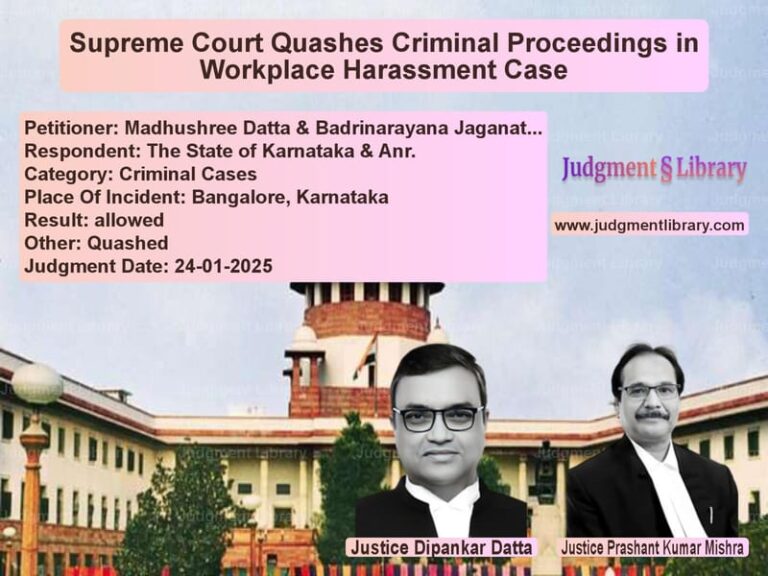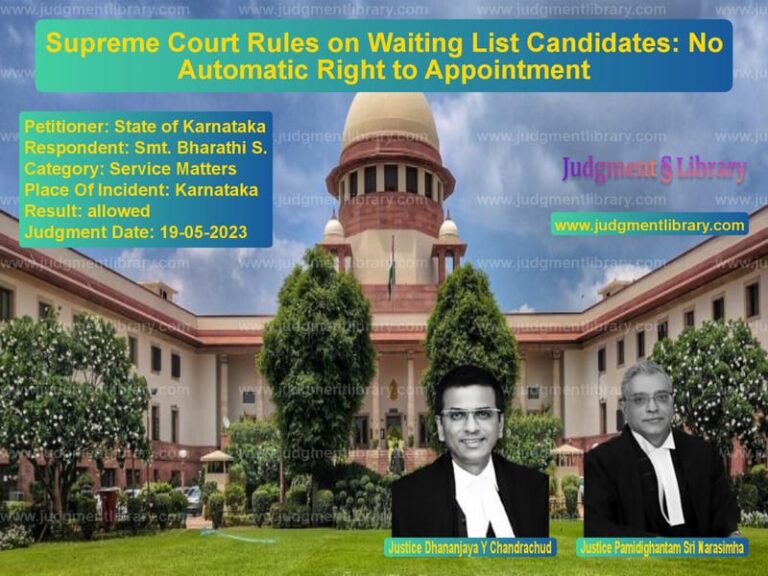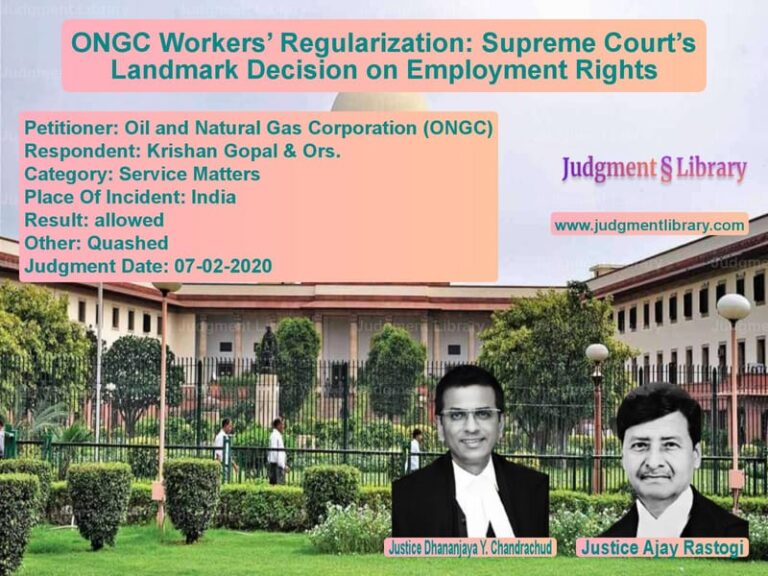Summoning of Additional Accused: Supreme Court Clarifies Scope of Section 319 CrPC
The Supreme Court of India delivered an important judgment on the powers of a trial court to summon additional accused under Section 319 of the Code of Criminal Procedure (CrPC). The case involved Sartaj Singh, who was the original informant and also an injured witness, challenging the decision of the Punjab and Haryana High Court that had quashed the order of the trial court summoning additional accused. The Supreme Court reinstated the trial court’s order, emphasizing that courts have the authority to summon additional accused based on prima facie evidence, even before cross-examination.
Background of the Case
The case originated from an attack on Sartaj Singh on July 27, 2016. He was severely injured and later lodged a First Information Report (FIR) under Sections 148, 149, 341, 323, 324, 307, and 506 of the Indian Penal Code (IPC). In his complaint, Sartaj Singh named several individuals, including Palwinder Singh, Satkar Singh, Rajwant Singh, and others as the assailants.
Read also: https://judgmentlibrary.com/default-bail-and-uapa-supreme-court-upholds-right-to-liberty/
The investigation led to the filing of a charge sheet against some accused, but others were excluded. Dissatisfied with this, Sartaj Singh moved the trial court under Section 319 CrPC, seeking to summon those individuals he had originally named. The trial court accepted his plea and issued summons. However, the Punjab and Haryana High Court set aside this order on revision petitions filed by the respondents, prompting an appeal to the Supreme Court.
Arguments by the Petitioner (Sartaj Singh)
- The trial court was justified in summoning the additional accused based on his deposition as an injured witness.
- The private respondents were named in the FIR and were specifically identified in his testimony.
- The High Court exceeded its jurisdiction by reappreciating the evidence at the summoning stage.
- The judgment of the Supreme Court in Hardeep Singh v. State of Punjab (2014) 3 SCC 92 established that the power under Section 319 CrPC should be exercised liberally to ensure justice.
- The evidence of a single injured witness is sufficient to summon an accused and even convict them if credible.
Arguments by the Respondents
- The power under Section 319 CrPC is extraordinary and should be used sparingly.
- There was no additional evidence apart from the statement of the complainant, which had already been considered by the investigating officer.
- The deposition of Sartaj Singh was a mere reiteration of the FIR and should not have been the sole basis for summoning the respondents.
- The trial court failed to recognize that the investigating officer had exonerated them after proper inquiry.
- The complainant was an interested witness as he himself was facing charges in a counter FIR regarding the same incident.
Supreme Court’s Observations and Judgment
The Supreme Court, while analyzing the law on the summoning of additional accused, made the following key observations:
- Evidence at the Summoning Stage: The Court ruled that even evidence given in examination-in-chief is sufficient to summon an accused. Cross-examination is not a prerequisite for exercising the power under Section 319 CrPC.
- Scope of Section 319 CrPC: The Court reaffirmed that Section 319 allows a trial court to summon any person not originally accused if there is evidence suggesting their involvement in the offense.
- Reliability of a Single Witness: The Court emphasized that an accused can be convicted based on the testimony of a single witness, provided it is credible.
- High Court’s Error: The Supreme Court criticized the High Court for going beyond the scope of Section 319 CrPC by assessing the merits of the case at the summoning stage.
- Prima Facie Standard: The Court reiterated that the standard of satisfaction for summoning additional accused is lower than the standard required for conviction. It should be stronger than a mere prima facie case but need not be as conclusive as the evidence needed for conviction.
The Court stated:
“If, on the basis of examination-in-chief, the court is satisfied that there is a prima facie case against the proposed accused, it may summon them to face trial under Section 319 CrPC. The High Court erred in interfering at this stage by reappreciating the evidence.”
Accordingly, the Supreme Court quashed the High Court’s order and restored the trial court’s decision summoning the additional accused.
Legal Principles Reaffirmed
This judgment reinforced several legal principles related to Section 319 CrPC:
- The trial court has the power to summon additional accused based on prima facie evidence without waiting for cross-examination.
- The testimony of a single witness, if credible, can form the basis for summoning an accused.
- The High Court should not interfere with summoning orders by reappreciating the evidence at an interlocutory stage.
- Section 319 CrPC aims to prevent the real perpetrators of an offense from escaping trial due to investigative lapses.
Impact of the Judgment
The Supreme Court’s ruling in this case is significant for criminal jurisprudence as it:
- Strengthens the role of trial courts in summoning additional accused.
- Clarifies that the power under Section 319 CrPC should be exercised based on prima facie evidence.
- Prevents accused individuals from escaping trial due to investigative lapses or manipulation.
- Emphasizes that an injured witness’s testimony carries substantial weight in summoning accused persons.
Conclusion
The Supreme Court’s decision in Sartaj Singh v. State of Haryana & Others reaffirms that courts have the duty to ensure that all guilty individuals face trial. The ruling strengthens the application of Section 319 CrPC by allowing summoning of additional accused based on credible prima facie evidence, preventing potential perpetrators from evading justice. This decision will serve as a guiding principle for trial courts in exercising their powers to bring all accused persons to trial effectively.
Petitioner Name: Sartaj Singh.Respondent Name: State of Haryana & Others.Judgment By: Justice M. R. Shah, Justice D. Y. Chandrachud.Place Of Incident: Haryana.Judgment Date: 15-03-2021.
Don’t miss out on the full details! Download the complete judgment in PDF format below and gain valuable insights instantly!
Download Judgment: sartaj-singh-vs-state-of-haryana-&-o-supreme-court-of-india-judgment-dated-15-03-2021.pdf
Directly Download Judgment: Directly download this Judgment
See all petitions in Bail and Anticipatory Bail
See all petitions in Attempt to Murder Cases
See all petitions in Judgment by Mukeshkumar Rasikbhai Shah
See all petitions in Judgment by Dhananjaya Y Chandrachud
See all petitions in allowed
See all petitions in supreme court of India judgments March 2021
See all petitions in 2021 judgments
See all posts in Criminal Cases Category
See all allowed petitions in Criminal Cases Category
See all Dismissed petitions in Criminal Cases Category
See all partially allowed petitions in Criminal Cases Category







